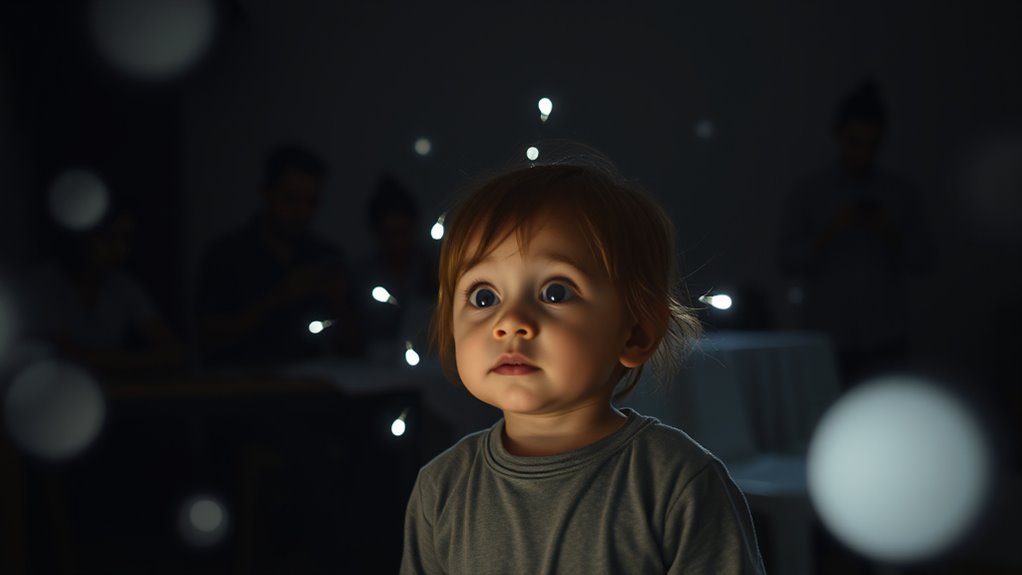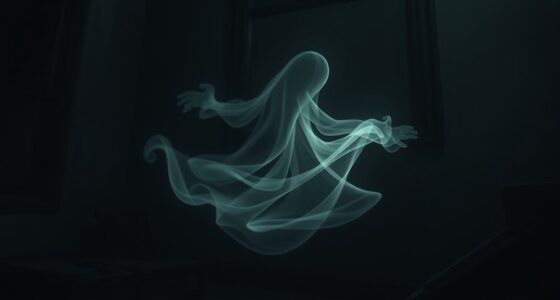Kids often have a heightened sensitivity to the supernatural, making them more likely to see ghosts than adults. Their openness, imagination, and emotional connections contribute to their ability to perceive spirits, often viewing them as friendly or comforting. Many children recount encounters with deceased relatives or comforting figures, which can affect their emotional development. If you want to learn about how parents can support their children’s experiences with the supernatural, there are fascinating insights ahead.
Key Takeaways
- Children possess heightened sensitivity to the supernatural, enabling them to perceive ghosts more easily than adults.
- Their openness and innocence contribute to a greater attunement to supernatural occurrences.
- Many children describe ghost encounters as friendly or comforting, unlike most adult perceptions.
- Cultural influences and imaginative play enhance children’s beliefs and experiences with ghosts.
- Parents’ validation of children’s ghost sightings supports their emotional development and encourages them to share their experiences.
Understanding Children’s Sensitivity to the Supernatural
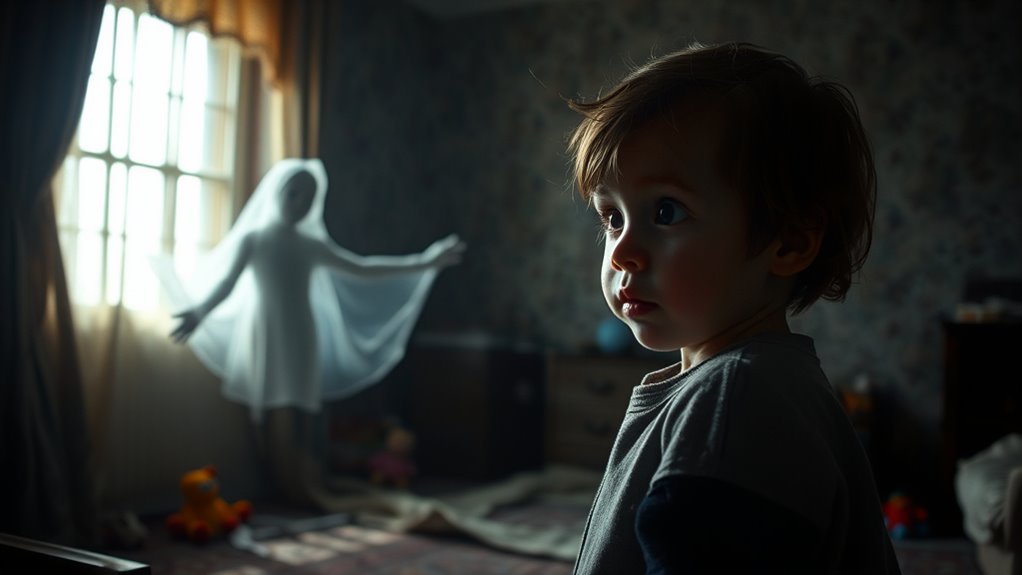
As children explore their world, their heightened sensitivity to energies and events often allows them to perceive ghosts and spiritual entities that adults might overlook. This unique sensitivity stems from their openness and innocence, making them more attuned to supernatural occurrences.
Research by intuitive healers, like Dr. Kim Peirano, suggests that many children report experiences with ghosts, often viewing them as friendly or comforting. This can lead to mixed reactions from parents, unsure how to address their child’s claims.
Notably, anecdotal evidence shows that 30%-50% of children may have imaginary friends or encounter spirits. Cultural influences, especially around events like Halloween, can further amplify their belief in the supernatural, enhancing their sensitivity to ghostly encounters.
Anecdotes of Child Ghost Sightings
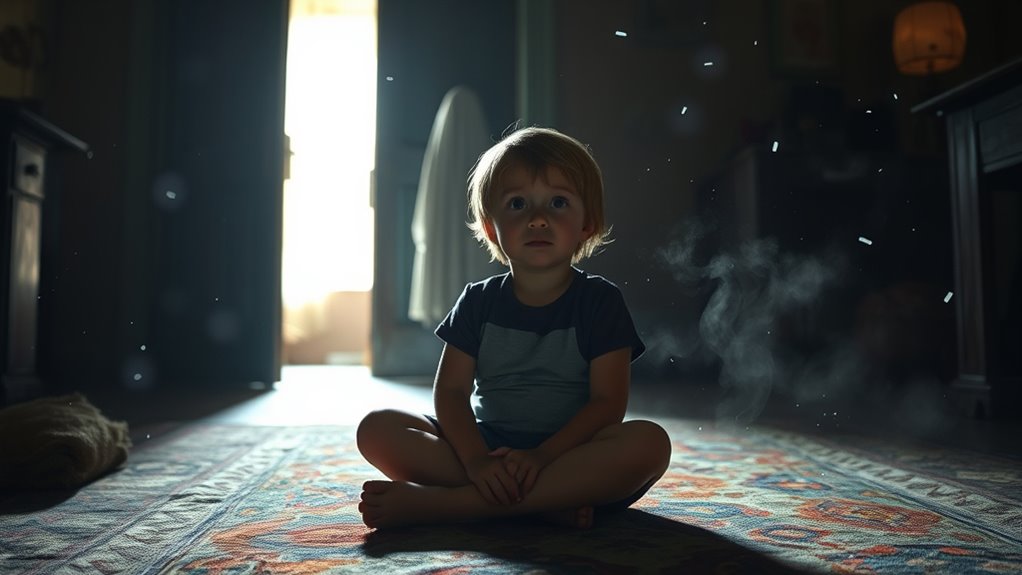
You might be surprised to hear how many kids have shared their ghost sightings, often describing encounters with comforting figures or even family members.
These stories can reveal a unique connection to the spirit world, showcasing how children interpret their experiences.
From friendly apparitions to warnings from beyond, these anecdotes spark curiosity about what kids really see.
Real-Life Sightings Documented
What makes children’s ghost sightings so fascinating? They often see what adults can’t, like the 3-year-old who spotted a little boy in pajamas or the 2.5-year-old inviting a deceased grandpa to sit with them. These encounters blur the lines between the real and the imaginary, creating a mix of awe and concern for parents.
| Child’s Age | Ghost Encounter |
|---|---|
| 2 years old | Recognized happy children in a cemetery |
| 3 years old | Warned about a woman in the basement |
| 2.5 years old | Invited a grandpa to join on the couch |
| 3 years old | Described a ghost friend in the living room |
Children’s ghost sightings often reveal their connections to the spirit world, leaving parents pondering the nature of these ghostly imaginary friends.
Family Member Connections
Children’s ghost sightings often reveal surprising connections to family members who’ve passed away, sparking curiosity and intrigue among parents. Many kids seem to see spirits of relatives they’ve never met.
For instance, a 3-year-old once claimed to see a woman warning, “Don’t hurt my mommy!” in the basement. In another case, a 2.5-year-old patted the couch, inviting their deceased grandfather to sit beside them.
Kids may even mention deceased family members during visits, reinforcing their ability to perceive these familial energies. You might hear a child overheard the name of a relative or refer to a ghost friend named after someone who passed away, illustrating the depth of these family member connections and the idea of past lives.
Comforting Spirit Encounters
While many might expect ghost sightings to be frightening, countless anecdotes reveal that kids often encounter spirits in a comforting manner. For instance, a little 2.5-year-old invited her deceased grandpa to sit on the couch, showcasing a warmth often absent in adult encounters.
Children frequently describe friendly spirits, like a playful little girl who just wants to join them at night. One 3-year-old even spotted a protective woman, warning, “Don’t hurt my mommy!”
These stories highlight how kids perceive spirits not as threats but as imaginary friends or guardians. Parents often notice their children’s ghostly companions bring comfort, leading to mixed feelings of fear and warmth.
Ultimately, these encounters reflect a unique bond between children and the spirit world.
The Role of Family Connections in Ghost Experiences
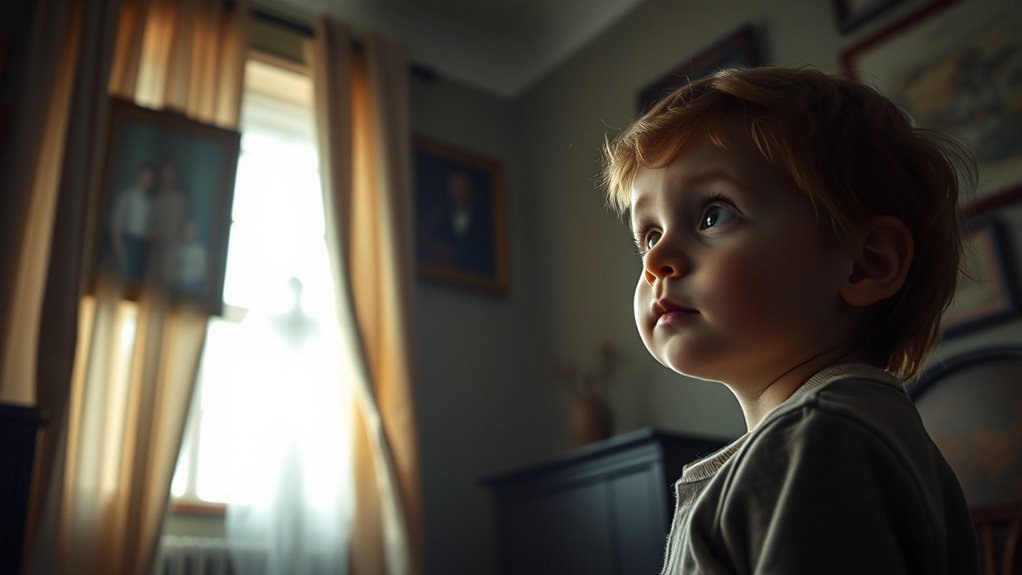
When kids experience ghostly encounters, they often report seeing deceased relatives, highlighting the strong emotional bonds that can transcend even death.
These interactions can provide comfort and healing, allowing children to process loss in a unique way.
Let’s explore how these family connections shape their ghost experiences and what messages they might convey.
Deceased Relatives’ Presence
Ghost experiences often reveal a profound connection between kids and deceased family members, illustrating how tightly woven family bonds can transcend the physical dimension. Many ghost sightings involve deceased relatives, showing that children often recognize and communicate with spirits they’ve never met.
For instance, a 2.5-year-old invited a deceased grandparent to sit beside them, showcasing an emotional connection that defies age and experience. Kids like Leo, who referred to a ghost friend named Mr. Hutchinson, often perceive these spirits as comforting figures.
Their ability to reference family members by name during encounters suggests a deep awareness and familiarity, allowing them to channel energy from deceased relatives. This unique connection offers a glimpse into how children navigate the spirit world.
Emotional Healing Through Ghosts
Emotional healing often comes from unexpected places, and for many children, interactions with spirits can provide a unique source of comfort. These connections often revolve around deceased family members, helping kids process their feelings of loss. A little girl might invite her grandparent to sit with her, creating a sense of emotional healing through these encounters.
Consider how these experiences manifest:
- Kids may warn loved ones about dangers after seeing spirits.
- They often recognize and talk about relatives they’ve never met.
- Ghosts can become imaginary friends, aiding in grief processing.
- Many children express joy and reassurance from these connections, reinforcing their familial bonds.
Through these interactions, kids find support and comfort, nurturing their emotional healing journey.
Parents’ Reactions to Children’s Ghost Encounters
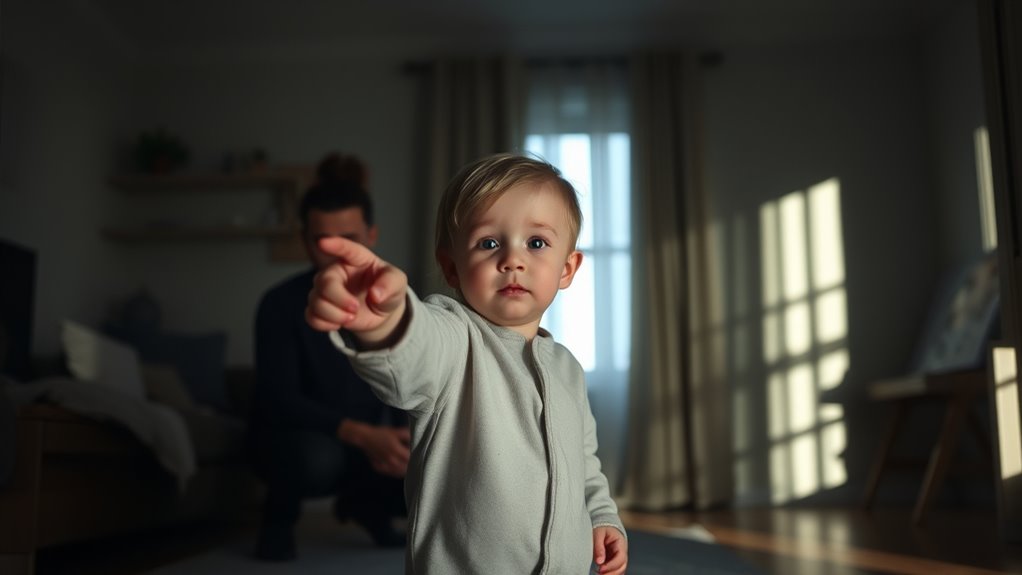
Though you might feel surprised or even concerned when your child shares a ghost sighting, it’s essential to recognize the significance of their experience. Your reaction can shape how they view their encounters.
Many parents choose to validate these ghost sightings instead of dismissing them, understanding that emotional support is vital. When you acknowledge their experiences, it encourages open dialogue, allowing them to share more.
Some kids may even stop mentioning their encounters if they sense disapproval. To create a safe environment, consider clearing home energies or engaging in imaginative play.
Reframing scary ghosts as friendly imaginary companions can alleviate fears and foster a deeper connection during these conversations, enhancing your child’s sense of security and understanding.
Ghosts and Imaginary Friends: Distinctions and Similarities

Imagination plays an essential role in childhood development, often blurring the lines between reality and fantasy. Kids might talk about ghosts existing, but they also create imaginary friends, which serve different purposes. Understanding these distinctions can help parents navigate their children’s strange experiences.
- Ghosts are often perceived as real entities.
- Imaginary friends are healthy manifestations of creativity and emotional processing.
- Approximately 30%-50% of children experience imaginary companions.
- Imaginary friends can help kids cope with loss or loneliness.
Recognizing these differences allows you to appreciate your child’s imaginative world while addressing their emotional needs. Instead of conflating ghosts and imaginary friends, focus on the context of their claims to support their healthy child development.
Psychological Perspectives on Children’s Ghost Sightings
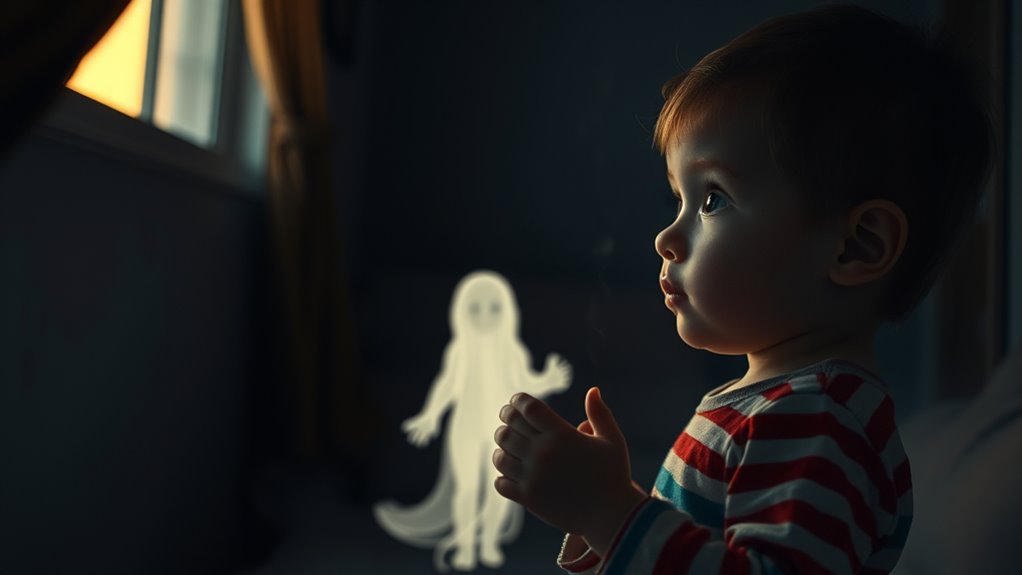
Children’s ghost sightings can often be perplexing for parents, especially when these experiences are intertwined with their imaginative play.
Research by Dr. Jacqueline Woolley shows that kids are still developing their understanding of reality versus fantasy, making them more likely to genuinely believe they see dead people. Psychological distress, such as parental divorce, can also manifest as claims of ghost sightings, linking their experiences to emotional states.
Children’s fertile imaginations can lead to vivid encounters resembling hallucinations, as their brains connect unrelated events and overlook contradictory evidence.
Developmental psychologists often view these sightings as part of healthy growth, encouraging you to engage with your child’s feelings rather than dismissing their claims outright.
Coping Strategies for Parents of Ghost-Sighting Children
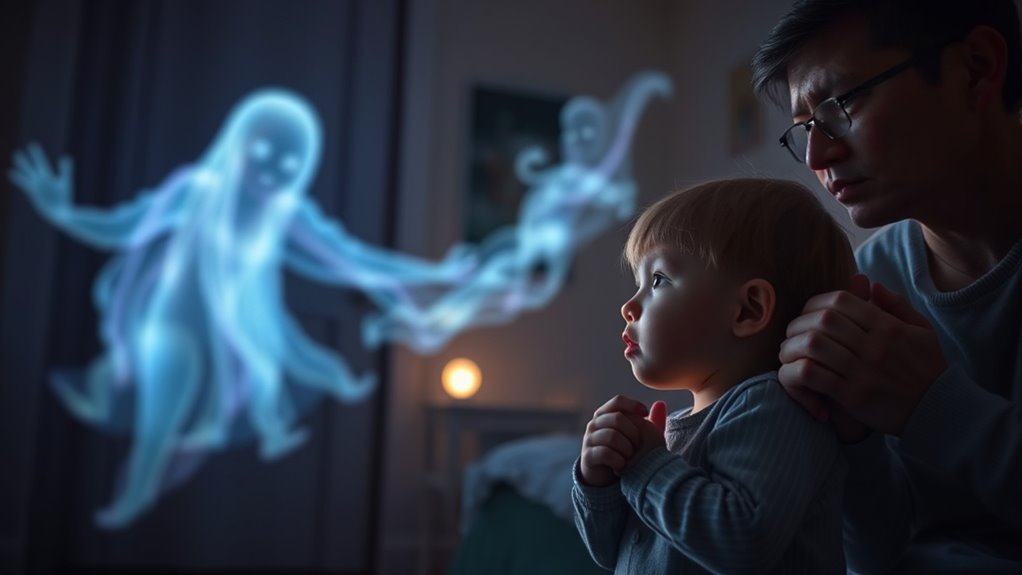
When your child shares a ghost sighting, it’s essential to validate their feelings right away. This helps them feel heard without dismissing their experiences.
Validating your child’s ghost sighting is crucial; it ensures they feel heard and their experiences are acknowledged.
To create a supportive atmosphere, consider these coping strategies:
- Encourage open dialogue about their fears, allowing them to describe the ghost in detail.
- Create a safe environment by remaining calm and reassuring, which prevents fear or embarrassment.
- Use imaginative play to soften the scary features of ghosts, transforming frightening encounters into friendly interactions.
- Tailor your responses to their emotional needs, perhaps by exploring with ghost-hunting equipment.
Cultural Influences on Children’s Beliefs in Ghosts

Understanding how cultural influences shape beliefs about ghosts can help you navigate your child’s experiences more effectively. Children absorb cultural beliefs, especially during events like Halloween, which heighten their awareness of the supernatural. When kids hear ghost stories or engage in discussions within their families, they’re more likely to report ghost sightings. This social context is essential in shaping their beliefs.
| Cultural Factors | Impact on Children’s Beliefs |
|---|---|
| Family Traditions | Sharing ghost stories boosts belief. |
| Seasonal Celebrations | Events like Halloween inspire imagination. |
| Community Narratives | Local tales reinforce supernatural concepts. |
| Parental Experiences | Personal anecdotes shape perceptions. |
| Media Influence | Movies and shows amplify ghostly ideas. |
These elements combine to cultivate a rich environment for your child’s belief in ghosts.
Frequently Asked Questions
Do Kids See Ghosts More Than Adults?
When it comes to children and ghost sightings, you might find it intriguing that many kids report experiencing supernatural encounters.
Their heightened sensitivity and vivid imaginations often lead them to perceive things adults overlook. As a child, you probably had a different perspective on reality, feeling more connected to your surroundings.
This openness tends to diminish as you grow older, influenced by societal norms that often dismiss such experiences as mere fantasy.
Can Children See Things That Aren’t There?
Yes, children can see things that aren’t there. Their vivid imaginations often blur the lines between reality and fantasy.
You might notice your child talking to imaginary friends or describing situations that seem impossible. This can stem from their unique brain development and heightened sensitivity to their surroundings.
While some experiences may reflect their creativity, it’s important to listen and validate their feelings, as this can shape their understanding of the world around them.
Why Do Children Say They See Ghosts?
Children often say they see ghosts because their imaginations run wild, tapping into their heightened sensitivity to emotions and environments.
You might notice they personify these experiences, creating stories around what they perceive. Cultural influences, like Halloween, also play a role, sparking discussions that amplify their beliefs.
Plus, changes in their lives can shape how they interpret these encounters, making them feel more real and significant to them.
Why Is My Child Seeing Scary Things in the House?
If your child’s seeing scary things in the house, it might stem from their heightened sensitivity to emotions and energies.
Kids often process their feelings through imaginative interpretations, especially when anxious or distressed. Instead of dismissing their fears, engage them in conversation.
Ask them to describe what they see and how it makes them feel. This open dialogue helps you understand their emotional state and can guide them in reframing these experiences into something less frightening.
Conclusion
In the domain of the supernatural, children often wander with open hearts and curious eyes, making them more attuned to ghostly encounters than adults. Their innocent perceptions can blur the line between reality and imagination, leaving parents both intrigued and concerned. By fostering open conversations and understanding their unique experiences, you can help navigate these mysterious encounters. Ultimately, embracing their sensitivity can illuminate the unseen, turning fear into fascination and wonder into wisdom.
